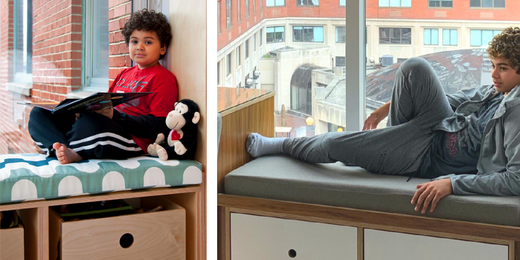Your Cart is Empty
Showroom open on weekends - by appointment
Showroom open on weekends - by appointment

Kids grow up fast, and transitioning them to different beds is an essential milestone in their growth and development. As kids evolve from babies to toddlers, elementary school age, and eventually to their teenage years, their sleeping needs shift. Knowing when to transition their beds is key to ensuring comfort, safety, and longevity in your furniture choices.
The first transition your child will make when it comes to beds is from a crib to a toddler bed. Because this is a change that basically every child will make, we've incorporated it into the design of our cribs. The side panels of our cribs are easily removable, and they quickly transform into a bed for a toddler, giving you years of more use from it.
How do you tell if your child is ready to transition from a crib to a toddler bed? Typically the transition occurs between 18 months old and 3 years old, but since every kid develops at their own pace you should make the decision by assessing their behavior. However, there’s no rush to move your child out of their crib. In fact, most parents would rather have their toddlers in their crib a bit longer to prevent them from getting out of bed on their own.
Signs it’s time to transition:
It is however, important to note that babies under 18 months are usually too small to transition, regardless of development pace. If you're unsure about whether it's time to move to a toddler bed, you can always bring your child by for a showroom visit and let our designers assess their interactions with the bed models we have here, or of course, consult your pediatrician.
Recommended beds: A toddler bed, junior bed, or a small twin bed with guardrails works well during this stage, ensuring safety while allowing for autonomy.
As previously mentioned, moving to a toddler bed typically happens between 18 months and 3 years old and often align with potty training and increased independence. It is however, important to note that babies under 18 months are usually too small to transition, regardless of development pace. If you're unsure about whether it's time to move to a toddler bed, you can always bring your child by for a showroom visit and let our designers assess their interactions with the bed models we have here, or of course, consult your pediatrician.
Considerations for choosing a toddler bed:
The next significant transition happens when your child is ready to start sleeping in a twin size bed. This shift typically happens between 3 ½ and 5 years old, depending on their size and comfort level in a toddler bed. This shift can coincide with developmental milestones like starting pre-school or kindergarten.
Signs it’s time to move to a twin size bed:
Recommended beds:
While there’s no age requirements for kids who sleep on the bottom bunk, bunk bed safety guidelines from the Consumer Product Safety Commission states that children younger than 6 years old should not sleep in the upper bunk. However, even at age 6 or 7, it's essential to assess your child’s personality and physical activity. If your child is particularly active or prone to jumping and climbing, waiting a little longer may be the safest route.
If you’re uncertain, our showroom allows children to test out bunk beds and loft beds in a controlled environment. Our designers can provide feedback on their readiness. For parents who prefer to ease into this transition, we offer convertible bunk bed models, like the Cabin or LoLo, which start as two twin beds on the floor and can later be stacked into a bunk bed as your child matures. Some of our bunk beds, like the Capsule, MiniBunk, and LoLo, have the bottom bunk sitting on the floor so it's safer for younger kids to sleep there.
Safely considerations for bunk beds:
As kids grow into their tween and teenage years, their needs for space, comfort, and functionality shift. The right bed can create a sense of personal space, encourage organization, and accommodate different activities like studying, reading, and socializing. Choosing the right bed depends on the size of the room, your child’s needs, and how much they’ll use the space for activities beyond sleeping.
Bed options based on room size and needs:
Transitional Considerations:
Custom beds can be a worthwhile investment at various stages of your child’s growth. Whether you're planning for long-term use or designing for specific spatial needs, custom options allow for flexibility, unique designs, and functional storage solutions. If you have something in mind that you can't find in one of our standard models, set up a showroom visit, home consultation, or remote consultation and let us sketch something completely new for you to accomplish any goals you have for your child's room.